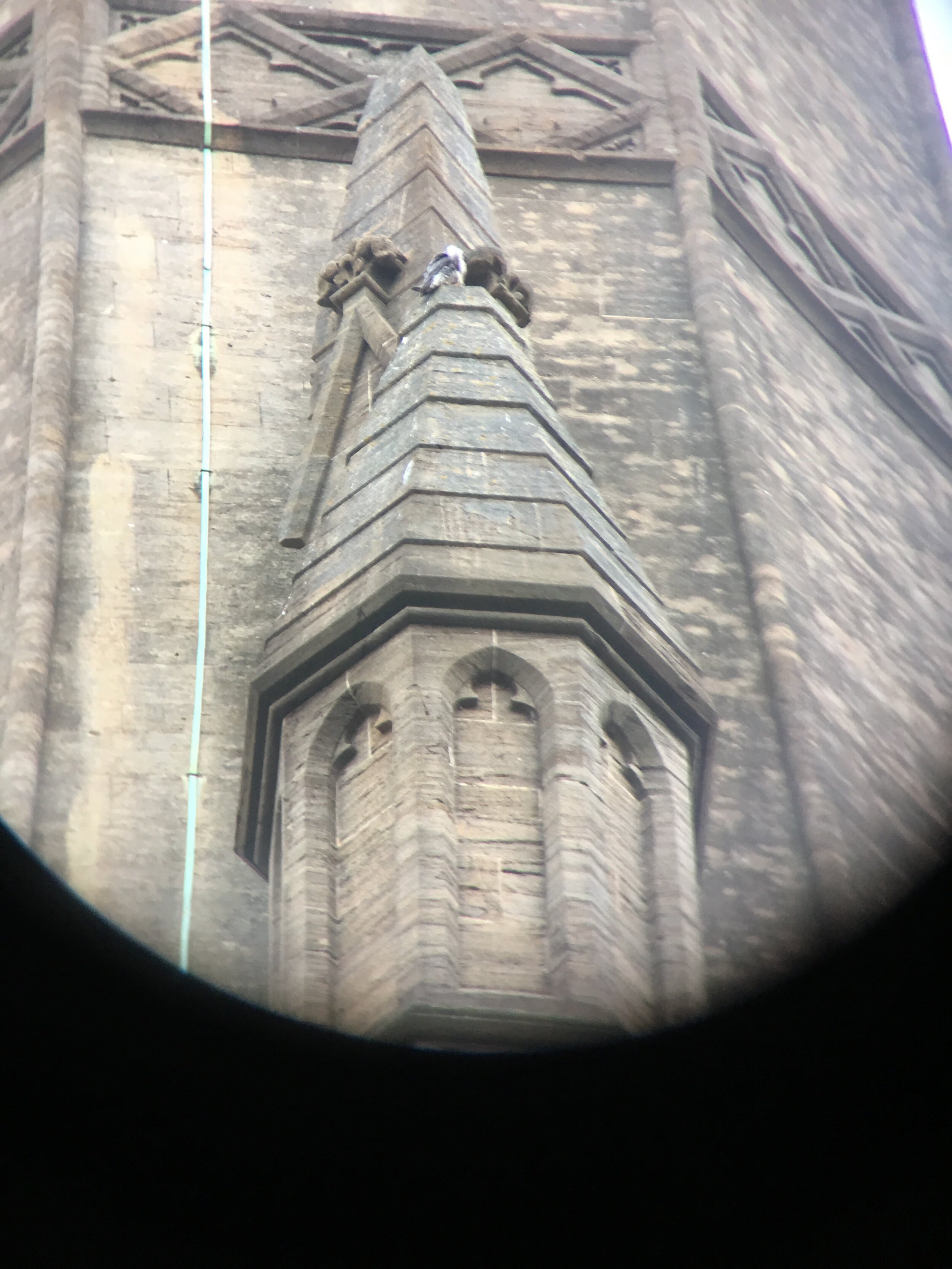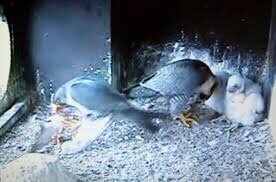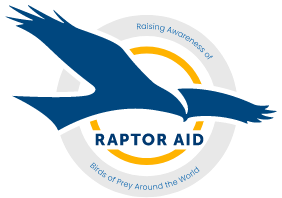Exeter Peregrines
Having just spent a weekend in Exeter at the university I was very lucky to get to spend some time with Peregrine expert Nick Dixon and the long time monitored Peregrines found in Exeter on St. Michaels church. Nick has been studying these birds for 20 years and if I remember correctly they have been breeding on the church for 21 years. They are an incredibly productive pair of birds and this year they laid 4 eggs of which two have hatched.  It's not unusual for urban Peregrines to produce clutches of 5 or 6 eggs and their chicks to hatch out much earlier than more rural pairs based on the wider abundance of prey available for urban birds. Last year the Exeter birds hatched two birds from 4 eggs and Nick has a theory behind why two eggs are have not hatched for two years consecutively. Based on the extensive monitoring by Nick and colleagues they get to know the birds very well, whilst sat in the beer garden with great views of the birds (beer garden - very convenient for Peregrine watching) Nick told me how the male bird seems to not be the best hunting bird but more interested in incubating and brooding the chicks. The male on several occasions has brought in the dried girdle of a pigeon from his food cache and while the female struggled to glean any meat from it the male has taken his chance to brood or incubate chicks/eggs. Nick has also observed how these pigeon girdles can be dangerous - on a couple of occasions he has seen the female get the girdle stuck around her leg and then she continues to try and incubate the eggs with this skeletal shackle knocking the eggs.
It's not unusual for urban Peregrines to produce clutches of 5 or 6 eggs and their chicks to hatch out much earlier than more rural pairs based on the wider abundance of prey available for urban birds. Last year the Exeter birds hatched two birds from 4 eggs and Nick has a theory behind why two eggs are have not hatched for two years consecutively. Based on the extensive monitoring by Nick and colleagues they get to know the birds very well, whilst sat in the beer garden with great views of the birds (beer garden - very convenient for Peregrine watching) Nick told me how the male bird seems to not be the best hunting bird but more interested in incubating and brooding the chicks. The male on several occasions has brought in the dried girdle of a pigeon from his food cache and while the female struggled to glean any meat from it the male has taken his chance to brood or incubate chicks/eggs. Nick has also observed how these pigeon girdles can be dangerous - on a couple of occasions he has seen the female get the girdle stuck around her leg and then she continues to try and incubate the eggs with this skeletal shackle knocking the eggs. How are such intimate views obtained? Well like several other urban Peregrine pairs around the country Exeters pair are also monitored by a new HD nest camera which can be viewed by anyone on the web. These websites give a fantastic live view of the life's of Peregrines without being intrusive. Things observed include whether the adults are ringed birds, date of laying and size of clutch, how many hatch and develop and what sort of food is being brought in to the chicks. Sadly it also sometimes shows things that some viewers may find distressing, this includes at another site last year the killing of a chick by a rogue female which eventually took over the nest site. This year I believe at the same site a video has been doing the rounds on social media of the adult female sat brooding very small chicks, something spooks her and she jumps off the ledge flicking one of the tiny chicks of the ledge with her - very distressing viewing but how often does this happen? Clearly it's part of the cycle and one of the problems predators face competing in what appears a very healthy environment for Peregrines where nest sites are becoming a premium. As humans we like to create a soap opera and story to wild animals going about life to help us connect and understand what is going on in their world.
How are such intimate views obtained? Well like several other urban Peregrine pairs around the country Exeters pair are also monitored by a new HD nest camera which can be viewed by anyone on the web. These websites give a fantastic live view of the life's of Peregrines without being intrusive. Things observed include whether the adults are ringed birds, date of laying and size of clutch, how many hatch and develop and what sort of food is being brought in to the chicks. Sadly it also sometimes shows things that some viewers may find distressing, this includes at another site last year the killing of a chick by a rogue female which eventually took over the nest site. This year I believe at the same site a video has been doing the rounds on social media of the adult female sat brooding very small chicks, something spooks her and she jumps off the ledge flicking one of the tiny chicks of the ledge with her - very distressing viewing but how often does this happen? Clearly it's part of the cycle and one of the problems predators face competing in what appears a very healthy environment for Peregrines where nest sites are becoming a premium. As humans we like to create a soap opera and story to wild animals going about life to help us connect and understand what is going on in their world. One of the most interesting things about the Exeter Peregrines is how the current pair have been documented attacking and killing Common Buzzards that enter their territory or airspace. I have witnessed various inter species territorial displays of aggression but the Peregrines at Exeter have taken it to another level, this pair have not only tackled wild Buzzard flying in their territory but they actively kill the birds. Nick has recovered several Buzzard corpses and witnessed countless mid air dog fights and deaths. Sadly I can't remember the current figure Nick stated but more can be found on a paper by Nick published in British Birds following this link.One thing is certain from Nick et al's observations you do not want to be a Buzzard flying past st.Michaels church, Exeter, you might end up with a sore head or worse! More details about Nick Dixons work can be found at hereThe Exeter Peregrines webcam is available at this page hereOne final point for readers - if you enjoy a webcam or two and the site has a donate button feel free to make a contribution. Often the hard work of people like Nick is unpaid and webcams can be incredibly expensive to put in place and stream. Nick has also created a nice booklets to support the costs of the new webcam and streaming which can be found hereSometimes I think that in this age of social media a like and a share is all these projects need but as annoying as it is conservation costs money.Thanks for reading, enjoy the webcams out there at the moment and coming soon will be Part two of our Philippines adventure.
One of the most interesting things about the Exeter Peregrines is how the current pair have been documented attacking and killing Common Buzzards that enter their territory or airspace. I have witnessed various inter species territorial displays of aggression but the Peregrines at Exeter have taken it to another level, this pair have not only tackled wild Buzzard flying in their territory but they actively kill the birds. Nick has recovered several Buzzard corpses and witnessed countless mid air dog fights and deaths. Sadly I can't remember the current figure Nick stated but more can be found on a paper by Nick published in British Birds following this link.One thing is certain from Nick et al's observations you do not want to be a Buzzard flying past st.Michaels church, Exeter, you might end up with a sore head or worse! More details about Nick Dixons work can be found at hereThe Exeter Peregrines webcam is available at this page hereOne final point for readers - if you enjoy a webcam or two and the site has a donate button feel free to make a contribution. Often the hard work of people like Nick is unpaid and webcams can be incredibly expensive to put in place and stream. Nick has also created a nice booklets to support the costs of the new webcam and streaming which can be found hereSometimes I think that in this age of social media a like and a share is all these projects need but as annoying as it is conservation costs money.Thanks for reading, enjoy the webcams out there at the moment and coming soon will be Part two of our Philippines adventure.

